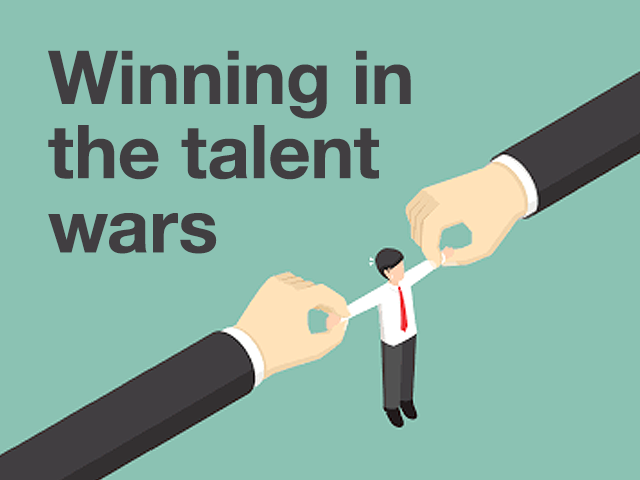
Winning in the talent wars
The new 1-week paradigm
Why do the GAFA (Google, Apple, Facebook and Amazon) companies seem to always get the best talent? Is it just because they’ve got strong Brand names, is it because they pay more or is it something much more straightforward that any company could replicate? Is there a “secret to their success” that other companies can learn from and embrace?
This short note sets out a possible answer and it all comes down to the new paradigm in the talent wars game. It’s about using Agile methods to win. Managing a recruiting process that is done simultaneously, not in waterfall. Prioritising, galvanising team, setting short time lines, having clear goals -day by day (not month by month): establishing a new 1-week paradigm.
It’s the idea of moving very fast once top talent is identified. It’s about building a momentum and excitement which sweeps the candidate off their feet. It’s about a mindset which has the same laser focus as winning a big new customer order. Some call it “closing the deal”. How can we harness and coordinate all our resources to land the win, how do we ensure we beat out the competition and make us the preferred option? Yes, we have to be in a good state revenue and profit-wide, yes, we need to show growth and career prospects, yes we need to have a clearly defined role and remit and set of responsibilities, yes, the pay and benefits needs to be competitive, but what’s the key to unlock all that potential and get the best talent on-board?

What’s this new 1-week paradigm? It’s about: organising so that once the key talent is identified, then line up the interviews and move to offer within one week. Overwhelm the candidate with interest, positivity and enthusiasm. Make the whole thing exciting. Use the one week to show “we can move fast” in this new tech-driven /digital world, we can be as smart as anyone and this demonstrates we really want you.
There’s been many books written about “competitive advantage through people”, showcasing case studies that demonstrate that people are the key assets of the organisation, that through people the company can win if the workforce is motivated and properly managed. Some companies will talk about being customer-centric and being customer-led. But the more savvy will talk about “power through people”, they will see the virtuous circle that if their employees are motivated and excited and informed and care about what the company is doing, then that will naturally translate through to the way they connect and engage with customers and through that they will drive market success and advantage. In the UK, leading retailer John Lewis is a good example of that, where all its staff are “partners” and all share in the profits of the company and where there is a constant cascade of values and ideals about equality and togetherness and feeling part of the company’s mission and purpose. Others like Adobe, AT&T, Next plc, Estee Lauder, Nationwide, Prudential Insurance, even the likes of Accenture and Deloitte, are all scored highly by employees as best places to work.
So if people are the key, then not surprising that there’s an ongoing war for the best, and not surprising that GAFA companies, being new to set up, have been able to adopt and embrace a best practice approach from day 1.
We all read nowadays about how companies should become more agile, how they should move from linear thinking to agile ways of working, So GAFA have embraced that ideal in their talent acquisition process. It’s not any more about let’s set up the first interview, see how that goes, then set up the next one, and then after that let’s do another. Now instead, the process is as follows:
Day 1 Monday: meet a top talent for the first time, if like what you meet.
Day 2: Tuesday: call first thing, invite back in
Day 3: Wednesday: line up 5 interviews all on the same day
Day 4: Thursday: make offer, invite to come in /meet the team, send contract by email end of day
Day 5 Friday: end of day drinks with all the interviewers, shake hands, sign.
Day 5 is “close the deal day”. What do we have to do to get this person on-board? Let’s see if we can capture the week’s momentum, let’s keep the buzz, nothing more powerful than having this person back with us, offer letter on the table, a “signing ceremony”, it doesn’t have to be done shyly and privately behind closed doors, let’s imagine it’s like a star footballer signing their new contract in front of the world’s press and photographers. We can make a show of it and in doing so show how much we want this person to join.
And yes, the offer letter can be subject to references and contain 3-month probation clauses to give the company added security and safeguard but in principle we all want to go home Friday evening with the deal closed, the job done, this brilliant new talent signed-up.
Why don’t all companies operate in this way? Why do many especially large organisations take months and months to go through a process of interviews and consideration? Is it any wonder that such companies with such a process may lose out on the best?
In recent times I have seen in my recruitment work a step-change in the level of interest and demand for example in Data, Analytics and Insight roles. Whether as Chief Data Officer, or Director of Analytics, or Head of Insight, companies all now can see the value that good data management can bring to underpin more effective customer and pricing decision-making.
As an example, one recent client of mine is a large Financial Services organisation. They created a new role which was to be their Chief Data Officer. The role was seen as important enough for the organisation that it would it report direct to the CEO and potentially could become a main Board position.
The company had talked about the need for urgency, they recognised there is a lot of demand for the best talent in this space, how it was imperative to move quickly, how this would be a high profile appointment for the company and so important to get the best.
A shortlist of candidates, identified, checked and ready to meet was completed in less than 3 weeks. This is what the company did next:
Week 1: meet the shortlist of candidates
Week 2: evaluate and consider and review feedback internally
Week 3: identify top 3 to move forward with
Week 4: get back with next step dates /meeting options for 2 weeks’ time
Week 6: second-round interviews
Week 7: review internal feedback
Week 8: decide on top 2 to move forward with
Week 10: third-round interviews
…and so on…with final interview at the end of 3 months.
Guess what happened? The final candidate gets an offer from the client but that same week they get approached by a GAFA company.
One week later candidate has a new offer to consider, and it’s exciting. “these other guys moved really quickly, they really showed they wanted me, they’re putting quite a lot of pressure on me to accept this week, I’ve been invited back in later today for a drinks /more informal meeting with the interviewers, I’ll let you know how that goes…
In the end the company did get their person. But it was touch and go for a couple of weeks while the candidate was getting to know a new quick Agile and fast-moving company and comparing that with the slower more traditional pace and wondering what that said about the two companies and ways of working and potential at each.
The good news is that not only did the client company eventually win-out but they also wanted to learn and understand what is was that the GAFA company was doing and how was it able to move so quickly.
The company has now established a new “top talent” interview process”. They felt that adopting the 1-week paradigm was at this stage perhaps too big a jump for them. But what about 1-month? It would not be the fastest but it would represent a step-change in their speed and agility and in doing so give the company a much better of chance of securing the top talent it wanted in the future.
To underpin that a new dashboard was established which would help the HR and Talent Acquisition teams to measure and monitor how efficiently they were able to manage the recruitment process:
- Time from brief to offer
- Time from first interview to offer
- Time from offer to close
- Number of interviews
- % of interviews on same day
- % offers accepted
What can recruiters and headhunters do to facilitate this? One easy solution is to speed up their own process. It’s no longer acceptable to spend 2 or 3 weeks indulging in “mapping the market” and then another 3 or 4 weeks while the recruiting firm trawls that market. That can mean 6 weeks or more from brief before the company even sees sight of an early shortlist.
This new “1-week paradigm” requires a fast approach from the off. In my recruiting work, I commit to get the shortlist within 3 weeks. I don’t waste time briefing junior researchers, I am able to leverage many yrs personal experience and networks and get straight to potential candidates on day 1 after the brief. By the end of week 1, I can already have the start of the shortlist ready to go. All that means momentum, speed and agility and the ability to get the process up and running very quickly. I’m finding that can make a significant difference as I’m focused on one role at a time, so all my efforts and energies are dedicated to getting to the best candidates and getting them excited and ready to interview.
In today’s fast-moving world, no process can be complete and no new ways of working can guarantee success. But it’s clear that to capture the best talent in the market, companies do have to learn to move more quickly, to develop that GAFA-like buzz and excitement with the candidate that ensures they are keen and ready to sign-up and join. It can come down to the simple process changes described here that any organisation can adopt and give itself the best chance of success.
Article also available for download as a PDF
Related Articles
- Technology vs People: Chapter 1
- Technology vs People: Chief AI Officer
- Finding talent just got easier
- A new 2025 business model
- Quiet Quitting: 7 rules for managing it
- Digital and Data Transformation: 10 keys to success
- Leading B2B companies using digital to power sales & profit growth
- Employee engagement is the key to digital change and transformation
- Evolution of the CDO role: 3 options for success
- Digital evolution of Marketing
- Winning in the talent wars
- Untapped potential of effective Customer Data & Analytics
© Michael de Kare-Silver 2026
Michael runs this specialist and international recruiting /headhunting practice Digital Prospects, helping companies recruit key talent where Digital Tech and /or Data skills and savvy are important.
Michael used to be MD at Argos.co.uk and of Experian.com, he is ex McKinsey strategy consulting and Procter & Gamble marketing, Michael provides a personal and dedicated advisory and recruitment service that delivers results and is built on treating people with kindness and respect.